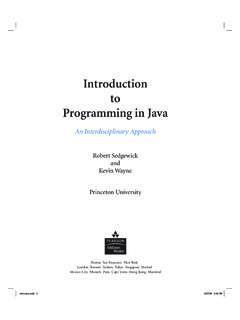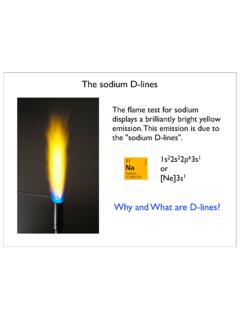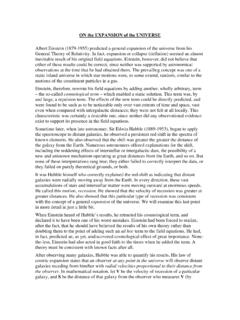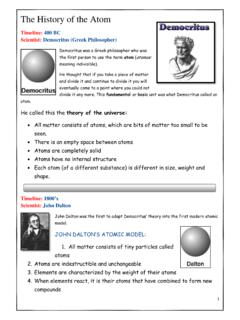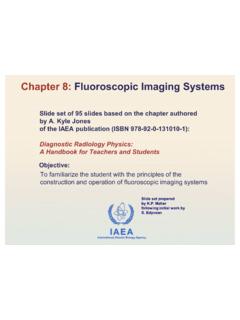Transcription of D.1 Classical Hebb’s Rule - MIT
1 1 Appedix D: Artificial Neural Network Artificial neural network (ANN) is a computational tool inspired by the network of neurons in biological nervous system. It is a network consisting of arrays of artificial neurons linked together with different weights of connection. The states of the neurons as well as the weights of connections among them evolve according to certain learning rules. Practically speaking, neural networks are nonlinear statistical modeling tools which can be used to find the relationship between input and output or to find patterns in vast database. ANN has been applied in statistical model development, adaptive control system, pattern recognition in data mining, and decision making under uncertainty.
2 Classical Hebb s Rule Hebb s rule is a postulate proposed by Donald Hebb in 1949 [1]. It is a learning rule that describes how the neuronal activities influence the connection between neurons, , the synaptic plasticity. It provides an algorithm to update weight of neuronal connection within neural network. Hebb s rule provides a simplistic physiology-based model to mimic the activity dependent features of synaptic plasticity and has been widely used in the area of artificial neural network. Different versions of the rule have been proposed to make the updating rule more realistic. The weight of connection between neurons is a function of the neuronal activity.
3 The Classical Hebb s rule indicates neurons that fire together, wire together . In the simplest form of Hebb s rule, Eq. ( ), wij stands for the weight of the connection from neuron j to neuron i ijijwxx= ( ) A B 2 Figure The plasticity within neural network. (A) The single connection between neuron i and neuron j. (B) A network of neurons connecting to neuron i.
4 The perceptron is type of artificial neural network. It can be seen as the simple feedforward network acting as the binary classifier. Hopfield Model Hopfield model is an associative memory model using the Hebb s rule for all possible pairs ij with binary units. The state variable xi of the neuron i takes on either on of the two possible values: 1 or -1, which corresponds to the firing state or not firing state, respectively. (1):()iijjijStsgnwS t += ( ) Where sgn is the sign function defined as follows: ()1if x0sgn x-1 if x 0 = < ( ) A B Figure The schematic diagram of neural network.
5 (A) Hopfield neuron. The unit fires if the weighted sum j wijSj of the inputs reaches or exceeds the threshold i [2]. (B) An example of three layer perceptron. The example of one pattern: The Drawbacks of Hebb s Rule 3 Though being simple, the Classical Hebb s rule has some disadvantages. Depending the application area of neural network, some drawbacks are tolerable but some need improvement. Generally speaking, for the purpose of data processing and statistical analysis, the speed and power of computation are valued more than the resemblance between the model and the physiological realism. On the other hand, for unraveling the memory formation mechanism and harvesting the emerging properties of biological network, the models need to be built upon a certain degree of biophysical basis.
6 Stability of Hebbian network For Classical Hebb s rule, there is no algorithm for synapses to get weaker and no upper bound that limits how strong the connectivity can get [3]. Therefore, it is intrinsically unstable. To overcome the stability problem, Bienenstock, Cooper, and Munro proposed an omega shaped learning rule called BCM rule. The general BCM improves Hebb s rule and takes the following form: ()ijijwijdwxxkwdt = ( ) There are two main differences between these two rules: the decay of synaptic weight with a rate constant kw and the nonlinear dependence of synaptic weight with respect to postsynaptic activities.
7 The nonlinearity was described by the postsynaptic activation function, (x). As shown in Figure , the activation function is negative for xi under threshold value w but grows positive once the postsynaptic activity becomes larger than w. Figure The activation function of synaptic strength with respect to postsynaptic activity. Hebb s rule poses linear dependence of synaptic strength on postsynaptic activity while BCM rule sets nonlinear omega-shaped dependence. The x-axis 4corresponds to postsynaptic activity, xi and the y-axis represents the activation function, (x) in Eq. ( ). The simplification of neuronal activities Under external stimulation, neurons fire and emit a series of pulses instead of a simple output level.
8 In Hebb s rule, only a single value xi is assigned to the neuron i to represent its activity. Yet the simplification results into the loss of information such as the threshold and tendency of firing as well as the detailed change in the short-term and the long-term plasticity. The variety and emerging properties may be the results of differentiated neurons. The network of these specialized neurons with individual attributes gives rise to bountiful functionality. The inability to model spike timing dependence It has been experimentally shown that the change in synaptic plasticity depends upon the relative spike timing between presynaptic and postsynaptic neurons.
9 Spike timing dependence has become an important experimental protocol in eliciting change in synaptic plasticity since its discovery. Although the role of temporal order was suggested in the original statement of Hebb s rule, the time window requirement is not incorporated in the equations. There are various subtypes of spike timing dependent plasticity (STDP); details are provided in Chapter 6: Modeling Spike Timing Dependent Plasticity. Some synapses demonstrate anti-Hebbian behavior in which presynaptic spiking preceding postsynaptic stimulation results into long term depression instead of potentiation. Still other synapses demonstrate only spike timing dependent potentiation or depression.
10 Therefore, modifying Classical Hebb s rule can lead to more versatile behavior of neural network which potentially may 1. Hebb D (1949) The Organization of Behavior. A Neuropsychological Theory. Wiley, New York, NY 2. Hertz J, Krogh A, Palmer RG (1991) Introduction to the theory of neural computation. Addison-Wesley Publishing Company, Redwood City, CA 3. Leon NC (2000) Memories and memory: a physicist's approach to the brain. International Journal of Modern Physics A 15:4069-4082










